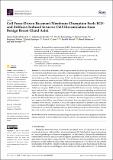Files in this item
Cell force-driven basement membrane disruption fuels EGF- and stiffness-induced invasive cell dissemination from benign breast gland acini
Item metadata
| dc.contributor.author | Gaiko-Shcherbak, Aljona | |
| dc.contributor.author | Eschenbruch, Julian | |
| dc.contributor.author | Kronenberg, Nils M. | |
| dc.contributor.author | Teske, Michael | |
| dc.contributor.author | Wolters, Benjamin | |
| dc.contributor.author | Springer, Ronald | |
| dc.contributor.author | Gather, Malte C. | |
| dc.contributor.author | Merkel, Rudolf | |
| dc.contributor.author | Hoffmann, Bernd | |
| dc.contributor.author | Noetzel, Erik | |
| dc.date.accessioned | 2021-04-16T16:30:12Z | |
| dc.date.available | 2021-04-16T16:30:12Z | |
| dc.date.issued | 2021-04-12 | |
| dc.identifier | 273832023 | |
| dc.identifier | 06eeb5f3-c385-4166-a96c-8a3a3ceb82b0 | |
| dc.identifier | 85103888206 | |
| dc.identifier | 000644316700001 | |
| dc.identifier.citation | Gaiko-Shcherbak , A , Eschenbruch , J , Kronenberg , N M , Teske , M , Wolters , B , Springer , R , Gather , M C , Merkel , R , Hoffmann , B & Noetzel , E 2021 , ' Cell force-driven basement membrane disruption fuels EGF- and stiffness-induced invasive cell dissemination from benign breast gland acini ' , International Journal of Molecular Sciences , vol. 22 , no. 8 , 3962 . https://doi.org/10.3390/ijms22083962 | en |
| dc.identifier.issn | 1422-0067 | |
| dc.identifier.other | Jisc: 3da1a74662be45dbba8146bee44e52c9 | |
| dc.identifier.other | ORCID: /0000-0002-4857-5562/work/92371925 | |
| dc.identifier.uri | https://hdl.handle.net/10023/23043 | |
| dc.description | Funded by the Deutsche Forschungsgesellschaft (DFG, German Research Foundation)-363055819/GRK2415, through SPP1782 within the projects H02384/2 and ME1458/8 and Engineering and Physical Sciences Research Council (EP/P030017/1) and the Alexander von Humboldt Stiftung (Humboldt-Professorship). | en |
| dc.description.abstract | Local basement membrane (BM) disruption marks the initial step of breast cancer invasion. The activation mechanisms of force-driven BM-weakening remain elusive. We studied the mechanical response of MCF10A-derived human breast cell acini with BMs of tuneable maturation to physical and soluble tumour-like extracellular matrix (ECM) cues. Traction force microscopy (TFM) and elastic resonator interference stress microscopy (ERISM) were used to quantify pro-invasive BM stress and protrusive forces. Substrate stiffening and mechanically impaired BM scaffolds induced the invasive transition of benign acini synergistically. Robust BM scaffolds attenuated this invasive response. Additional oncogenic EGFR activation compromised the BMs’ barrier function, fuelling invasion speed and incidence. Mechanistically, EGFR-PI3-Kinase downstream signalling modulated both MMP- and force-driven BM-weakening processes. We show that breast acini form non-proteolytic and BM-piercing filopodia for continuous matrix mechanosensation, which significantly push and pull on the BM and ECM under pro-invasive conditions. Invasion-triggered acini further shear and compress their BM by contractility-based stresses that were significantly increased (3.7-fold) compared to non-invasive conditions. Overall, the highest amplitudes of protrusive and contractile forces accompanied the highest invasiveness. This work provides a mechanistic concept for tumour ECM-induced mechanically misbalanced breast glands fuelling force-driven BM disruption. Finally, this could facilitate early cell dissemination from pre-invasive lesions to metastasize eventually. | |
| dc.format.extent | 19 | |
| dc.format.extent | 7063336 | |
| dc.language.iso | eng | |
| dc.relation.ispartof | International Journal of Molecular Sciences | en |
| dc.subject | Basement membrane | en |
| dc.subject | Mechanobiology | en |
| dc.subject | Mechanically driven cancer progression | en |
| dc.subject | Mechanosensing | en |
| dc.subject | Neoplasm invasion | en |
| dc.subject | Breast cancer invasion | en |
| dc.subject | Cell force | en |
| dc.subject | Mechanosensory transduction | en |
| dc.subject | Filopodia | en |
| dc.subject | QC Physics | en |
| dc.subject | QH301 Biology | en |
| dc.subject | RC0254 Neoplasms. Tumors. Oncology (including Cancer) | en |
| dc.subject | DAS | en |
| dc.subject | SDG 3 - Good Health and Well-being | en |
| dc.subject.lcc | QC | en |
| dc.subject.lcc | QH301 | en |
| dc.subject.lcc | RC0254 | en |
| dc.title | Cell force-driven basement membrane disruption fuels EGF- and stiffness-induced invasive cell dissemination from benign breast gland acini | en |
| dc.type | Journal article | en |
| dc.contributor.sponsor | EPSRC | en |
| dc.contributor.institution | University of St Andrews. School of Physics and Astronomy | en |
| dc.contributor.institution | University of St Andrews. Sir James Mackenzie Institute for Early Diagnosis | en |
| dc.contributor.institution | University of St Andrews. Centre for Biophotonics | en |
| dc.contributor.institution | University of St Andrews. Biomedical Sciences Research Complex | en |
| dc.identifier.doi | https://doi.org/10.3390/ijms22083962 | |
| dc.description.status | Peer reviewed | en |
| dc.identifier.url | https://www.mdpi.com/journal/ijms/special_issues/Biomechanics_Cancer_Progression | en |
| dc.identifier.grantnumber | EP/P030017/1 | en |
This item appears in the following Collection(s)
Items in the St Andrews Research Repository are protected by copyright, with all rights reserved, unless otherwise indicated.

